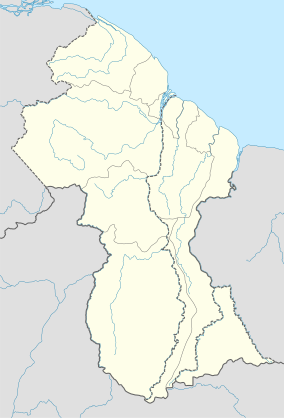Iwokrama Forest
| Iwokrama Forest | |
|---|---|
IUCN category VI (protected area with sustainable use of natural resources) | |
 | |
 | |
| Location | Central Guyana |
| Nearest city | Kurupukari |
| Coordinates | 4°30′N 59°00′W / 4.5°N 59°WCoordinates: 4°30′N 59°00′W / 4.5°N 59°W |
| Area | 3,716.1 km2 (1,434.8 sq mi)[1] |
| Established | 1996 |
| Governing body | |
| Website | Iwokrama.org |
The Iwokrama Forest is a 3,716 square kilometres (1,435 sq mi) nature reserve of central Guyana located in the heart of the Guiana Shield,[2] one of the four last pristine tropical forests in the world (Congo, New Guinea, and the Amazon rainforest are the others).[3] It represents an important transition zone in rainfall, landforms, human histories and biological communities.
At its widest, the area is 85 km (53 mi), and the greatest extent in a north-south direction is 80 km (50 mi). The Georgetown–Lethem Road dissects the forest, traversing about 72 km (45 mi) between the northeastern and southern boundaries. The forest lies between 4° and 5° north latitude and 58.5 and 59.5 degrees west longitude.[3]
The Iwokrama Forest is bordered to the west by the Pakaraima Mountains and to the east by the isolated highlands scattered through central-east Guyana. It is also bordered by savannahs in the southwest and northeast of Guyana. The Essequibo River forms the eastern boundary. The northern boundary is the Siparuni River. The Burro-Burro River runs through the centre, and most of its watershed is within the forest.[3]
The area is covered with lowland tropical forest, and dominated by tall tropical trees with a dense canopy 20 to 30 metres (70 to 100 ft) high.

The Iwokrama Forest's ecosystem is located at the juncture of Amazonian and Guianan flora and fauna. As a result, it contains high species richness and several species of animals that are threatened or extinct across most of their former geographic ranges, like the giant anteater.
The Iwokrama Forest has the highest species richness for fish (over 420 described so far) and bats (90) for any area this size in the world. It also has extraordinarily high bird diversity (over 500).[4] Iwokrama Forest has also been identified as a global hotspot for several plant families, including Lecythidaceae and Chrysobalanaceae.[4]
At 300 metres high, the form the geographic focal point of the Iwokrama Forest.[5] They once provided a "place of refuge" for the Macushi people. In 1996, The Iwokrama International Centre for Rain Forest Conservation and Development was established to manage the forest.[2] The centre and the forest are named after this striking mountain formation.
References[]
- ^ "Iwokrama International Centre". Protected Planet. Retrieved 25 March 2021.
- ^ a b "About Us". Iwokrama.org. Retrieved 28 August 2020.
- ^ a b c "Iwokrama Forest Reserve". Guyana PNC. Retrieved 28 August 2020.
- ^ a b "Iwokrama Rainforest". Wildlife Worldwide. Retrieved 28 August 2020.
- ^ "Turtle Mountain". Guyana Times International. Retrieved 28 August 2020.
External links[]
| Wikimedia Commons has media related to Iwokrama Forest. |
- IUCN Category VI
- Geography of Guyana
- Natural history of Guyana
- Protected areas of Guyana
- Trees of Guyana
